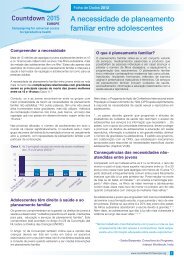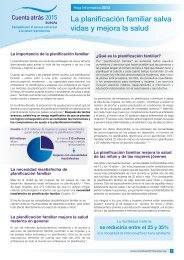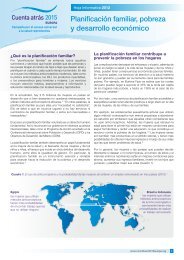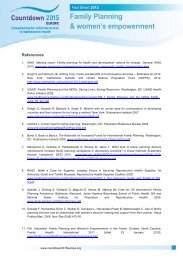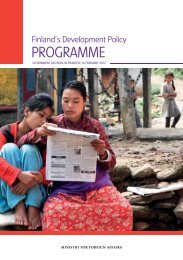more remote areas are most likely to have faith-based healthunits, <strong>for</strong> example, the Catholic organizations usually go deeperinto villages, but they don’t provide contraceptives. <strong>The</strong>y do talkabout family planning and natural methods, and they say if youwant modern methods, we can’t provide them here. To me theissue of knowledge and access are not matching up. We needan alternative method so that women can also access services,not just knowledge.”– Dr. Moses Muwonge, M.D., Health Logistics Consultant, Uganda“Most social marketing entities and projects do outreach,maybe one outreach in an area in a year. So if anyone missesthat, they’ve missed their chance. To me, we have a mismatchbetween giving out the message and actually providing theservices.”– Dr. Moses Muwonge, M.D., Health Logistics Consultant, Uganda“<strong>The</strong>re’s an organization that has initiated a social franchisingmodel youth centre, and sold it to local governments, andabout ten local government units have used that model. <strong>The</strong>yoffer counselling and in<strong>for</strong>mation, but not supplies. So there’sreally a disconnect: these centres just provide counselling andin<strong>for</strong>mation, and people have to get the supplies they need at apharmacy or a private clinic.”– Bryant Gonzales,Youth Coordinator, <strong>Family</strong> <strong>Planning</strong> Association of the Philippines“We conducted <strong>for</strong>mal focus group discussions with youngpeople in one of our projects, and it emerged that emergencycontraception is in huge demand, but people aren’t trained todistribute it. Again, demand and supply gaps and in<strong>for</strong>mationgaps are huge issues in many states in India.”– Sarita Barpanda,Country Programme Advisor, Interact Worldwide, IndiaVulnerable groups need services, too“<strong>The</strong>re was a programme initiated by the Ministry of Health andPopulation Office in the early 2000s, which involved setting upyouth centres in every town through local government units.That wasn’t sustainable, though: within two years all the youthcentres were gone. Many of the centres we have now areset up by reproductive health organizations rather than theGovernment.”– Bryant Gonzales,Youth Coordinator, <strong>Family</strong> <strong>Planning</strong> Association of the Philippines“One of our clinics provides services to young sex workers,who migrated there because of the nearby American militarybase. <strong>The</strong>y were really happy that we operated in that areabecause it meant they didn’t have to go to the next city to getpap smears, contraceptives and other essential services. Manyof these sex workers were young women not native to thatprovince or village; they migrated there so were isolated fromtheir families.”– Bryant Gonzales,Youth Coordinator, <strong>Family</strong> <strong>Planning</strong> Association of the Philippines“We’ve worked in both rural areas and urban slums, and theissues are the same. <strong>The</strong> only difference is that in<strong>for</strong>mation andsupplies are more easily available in urban areas if you have themoney to buy them; in the rural areas there is simply no accessat all.”– Sarita Barpanda,Country Programme Advisor, Interact Worldwide, India“When a right-wing party took power in Mexico, although theywere not opposed to family planning, they were also not openlyin favour of it. As a result, mass media campaigns <strong>for</strong> familyplanning stopped. <strong>The</strong>se were very important campaigns,particularly <strong>for</strong> adolescents. Not surprisingly, much of the unmetneed <strong>for</strong> family planning in Mexico is among adolescents.<strong>The</strong> complete range of contraceptive methods should beavailable to people throughout Mexico, according to the centralGovernment. This is documented on the National MedicinesList and, it is required by law. But if you go to the states, you seethat the availability of contraceptives is based on the values andmorals of high-level decision makers such as the local Ministryof Health and the Governor. If they decide that contraceptivesshould not be available to adolescents, or that sex educationshould not be taught as part of the basic school curriculum,then adolescents do not get these services. Basically, statelevelauthorities can decide that family planning should not beencouraged <strong>for</strong> adolescents. This leads to unmet need and allof the consequences associated with it, such as unplannedpregnancies.We are advocating strongly at the national level to ensure thatcontraceptive supplies are labelled as strategic supplies, andthat they are purchased at the central level. It is important <strong>for</strong>NGOs to continue making our governments accountable at alllevels and at all times – central, state, local and communitygovernments alike.”– Esperanza Delgado,Director of In<strong>for</strong>mation and Evaluation, MEXFAM22 www.countdown<strong>2015</strong>europe.org
4.4 Facts and statistics: future projections of unmet need••If contraceptive use remains stable, the world populationcould reach 11.9 billion by 2050. <strong>The</strong> scenario could worsenif contraceptive use declines, <strong>for</strong> example, due to lack ofinvestment in family planning (Speidel, Sinding et al. 2009).••Low growth scenarios put the world’s population at 7.8billion by 2050, compared to 7 billion today. This assumesthat contraceptive use will grow faster than it is rising now.It has been reported that the most likely median scenario isthat it will grow to 9.7 billion by 2050, assuming a substantialincrease in the number of contraceptive users in developingcountries (Speidel, Sinding et al. 2009).••1.5 billion adolescents are entering their sexual andreproductive years (IPPF 2008; UN 2009).••<strong>The</strong> number of women of reproductive age (between ages15 and 49) will grow by almost 33% in the next decade(Ross and Stover 2009).••Between 2008 and <strong>2015</strong>, the number of family planningusers will increase from 645 million to 709 million, a projectedincrease of 106 million (RHSC).4.5 Facts and statistics: international agreements related to family planning••In 1994, 179 governments signed the Programme ofAction of the International Conference on Population andDevelopment (ICPD), committing to ensuring access <strong>for</strong>all to reproductive health and family planning supplies andservices by the year <strong>2015</strong>.••In 2000, 189 heads of state adopted the UN MillenniumDeclaration and established eight Millennium DevelopmentGoals (MDGs), eventually including a target aimed atensuring universal access to reproductive health by theyear <strong>2015</strong>. Tracking progress includes indicators such ascontraceptive prevalence rate and the unmet need <strong>for</strong> familyplanning, which recognizes that access to contraceptives isan essential component to achieving universal access.••Approximately 356,000 pregnancy-related deaths occurannually in developing countries (WHO 2010). Whilematernal mortality declined by one-third between 1990 and2008, this figure still remains high, and the ef<strong>for</strong>t to reducematernal mortality (MDG 5) is the development goal whichhas progressed the least (Barot 2008).••<strong>The</strong> Muskoka Initiative on Maternal, Newborn and ChildHealth is a funding initiative announced at a G8 summit in2010 which commits member nations to collectively spendan additional US$5 billion between 2010 and <strong>2015</strong> toaccelerate progress toward the achievement of MDGs 4 and5 in developing countries.www.countdown<strong>2015</strong>europe.org23








